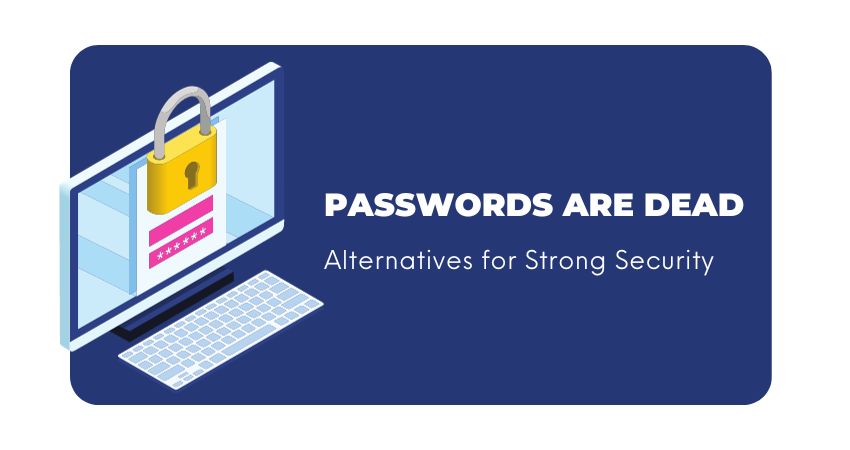Table of Contents
- Introduction
- 1) Biometric Authentication
- 2) Two-Factor Authentication (2FA)
- 3) Passwordless Authentication
- 4) Multi-Factor Authentication (MFA)
- 5) Zero Trust Security
- FAQs
- Why are traditional passwords considered insecure, and what are their limitations?
- What are the most effective alternatives to passwords for strong security?
- Are biometrics really secure, and what about privacy concerns?
- How can organizations transition to passwordless authentication, and what are the challenges involved?
- What is Zero Trust security, and how does it differ from traditional security models?
- Conclusion
- Read More Articles
Introduction
In a digital age where personal and corporate information is constantly under threat, the traditional password has proven itself to be increasingly inadequate. Data breaches are on the rise, and cybercriminals have become more sophisticated in their methods. As a result, the need for stronger security measures has never been more pressing. This blog explores the limitations of traditional passwords and delves into alternatives that offer enhanced security.
1) Biometric Authentication
The Rise of Biometric Authentication
Biometric authentication is revolutionizing the way we secure our digital lives. By using unique physical or behavioral traits, such as fingerprints, facial features, or iris scans, biometric authentication provides a highly secure and convenient way to verify one’s identity. This section explores the concept of biometric authentication and its advantages.
Advantages of Biometric Authentication
Improved Security: Biometric data is extremely difficult to replicate, making it an excellent defense against identity theft and impersonation.
Convenience for Users: Users no longer need to remember complex passwords, leading to a smoother and more user-friendly authentication process.
Reducing the Risk of Password-Related Attacks: Since there are no passwords to steal, common attacks like phishing and brute force become less effective.
Challenges and Concerns
Despite its many advantages, biometric authentication comes with its own set of challenges and concerns. Privacy issues, vulnerability to spoofing, and the risk of biometric data breaches are all areas that must be carefully addressed.
2) Two-Factor Authentication (2FA)
Strengthening Security with 2FA
Two-Factor Authentication (2FA) adds an extra layer of security by requiring users to provide two different authentication factors before granting access. This section explains what 2FA is, how it works, and provides examples of 2FA methods.
Benefits of 2FA
Enhanced Security: Even if a password is compromised, an attacker would still need the second factor to gain access.
Protection Against Password Leaks: 2FA mitigates the risk of unauthorized access in case of password leaks or breaches.
Reducing the Risk of Unauthorized Access: Unauthorized users are less likely to gain access when 2FA is in place.
Implementation Challenges
User resistance to change, compatibility issues, and contingency plans for 2FA failures are hurdles that organizations may face when implementing 2FA.
3) Passwordless Authentication
The Future of Authentication: Passwordless
Passwordless authentication eliminates the need for traditional passwords altogether. This section explores what passwordless authentication entails and provides examples of how it is implemented.
Benefits of Passwordless Authentication
Enhanced Security: Passwordless methods are often more secure than traditional passwords.
Improved User Experience: Users appreciate the simplicity of passwordless authentication.
Reduced Password-Related Support Costs: Fewer password-related support requests translate to cost savings for organizations.
Transitioning to Passwordless
Migrating from password-based systems, integrating passwordless into existing infrastructure, and ensuring user acceptance are key considerations when adopting passwordless authentication.
4) Multi-Factor Authentication (MFA)
Layered Security with MFA
Multi-Factor Authentication (MFA) takes security to the next level by requiring multiple authentication factors. This section explains MFA’s concept, how it combines different factors, and provides practical applications.
Advantages of MFA
Comprehensive Security: MFA offers robust protection against a wide range of threats.
Adaptability to Evolving Threats: MFA can evolve to counter new threats and vulnerabilities.
Regulatory Compliance: MFA helps organizations meet compliance requirements in various industries.
Overcoming MFA Challenges
Usability, management complexity, and cost considerations are factors organizations need to address when implementing MFA.
5) Zero Trust Security
Shifting to Zero Trust
The Zero Trust security model challenges the traditional “trust but verify” approach. This section explains the concept of Zero Trust, the role of continuous authentication, and its relevance in remote and hybrid work environments.
Zero Trust Components
Identity and access management (IAM), network segmentation, and continuous monitoring and risk assessment are the key components of the Zero Trust model.
Challenges and Implementation Tips
Implementing Zero Trust can be complex and may require cultural and organizational changes. Careful vendor selection is also crucial for a successful implementation.
FAQs
Why are traditional passwords considered insecure, and what are their limitations?
What are the most effective alternatives to passwords for strong security?
Are biometrics really secure, and what about privacy concerns?
How can organizations transition to passwordless authentication, and what are the challenges involved?
What is Zero Trust security, and how does it differ from traditional security models?
Conclusion
In a world where traditional passwords are increasingly vulnerable, it’s clear that alternatives are needed to ensure robust security. Whether through biometric authentication, 2FA, passwordless methods, MFA, or the Zero Trust model, organizations have a range of options to choose from. The key is to select the right combination of security measures to protect valuable data and systems effectively. As we move forward into the future, a multi-faceted approach to security will be paramount in safeguarding against ever-evolving threats.
Read More Articles
Cyber Security Trends: What’s Hot in 2023
Cyber Hygiene: A Daily Routine for Online Safety
Cyber Security in the Workplace: Best Practices
The Ultimate Guide to Cyber Security Essentials
Don’t Be a Victim: Protect Your Online Privacy

